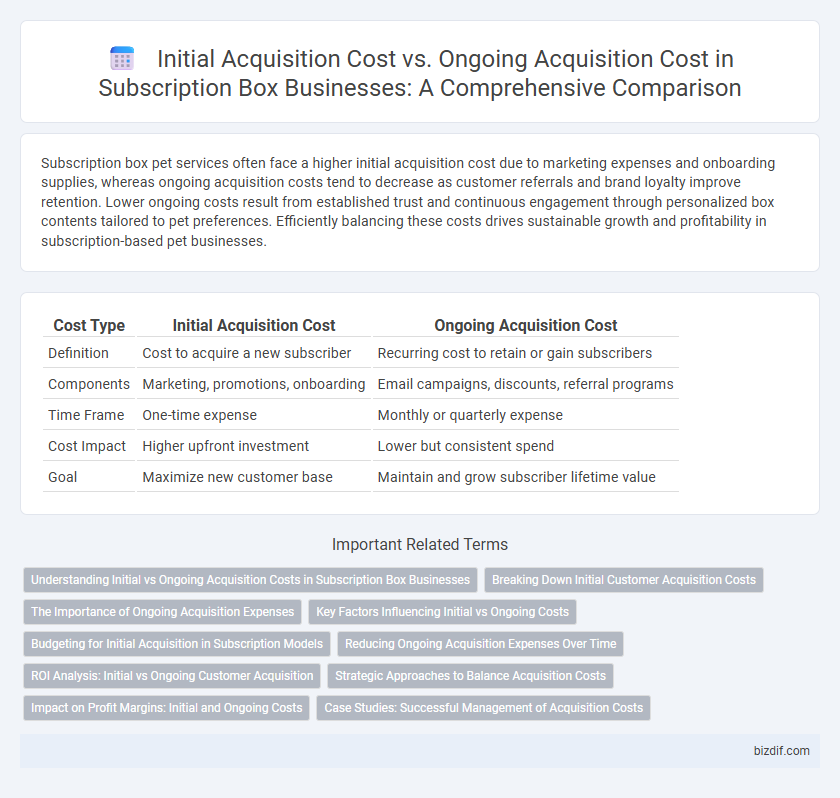Subscription box pet services often face a higher initial acquisition cost due to marketing expenses and onboarding supplies, whereas ongoing acquisition costs tend to decrease as customer referrals and brand loyalty improve retention. Lower ongoing costs result from established trust and continuous engagement through personalized box contents tailored to pet preferences. Efficiently balancing these costs drives sustainable growth and profitability in subscription-based pet businesses.
Table of Comparison
| Cost Type | Initial Acquisition Cost | Ongoing Acquisition Cost |
|---|---|---|
| Definition | Cost to acquire a new subscriber | Recurring cost to retain or gain subscribers |
| Components | Marketing, promotions, onboarding | Email campaigns, discounts, referral programs |
| Time Frame | One-time expense | Monthly or quarterly expense |
| Cost Impact | Higher upfront investment | Lower but consistent spend |
| Goal | Maximize new customer base | Maintain and grow subscriber lifetime value |
Understanding Initial vs Ongoing Acquisition Costs in Subscription Box Businesses
Initial acquisition costs in subscription box businesses typically include marketing expenses, promotional offers, and onboarding incentives aimed at attracting new customers. Ongoing acquisition costs encompass retention strategies such as personalized content, loyalty rewards, and referral programs designed to maintain subscriber engagement and reduce churn. Analyzing the balance between these costs is essential for optimizing customer lifetime value and ensuring sustainable growth.
Breaking Down Initial Customer Acquisition Costs
Breaking down initial customer acquisition costs reveals significant expenses in marketing, promotions, and onboarding efforts unique to subscription boxes, often exceeding ongoing acquisition costs per customer. These upfront investments cover targeted advertising campaigns, influencer partnerships, and personalized welcome kits designed to attract and engage new subscribers. Comparing these expenses to ongoing retention-focused acquisition activities highlights the strategic balance needed for sustainable growth in subscription-based businesses.
The Importance of Ongoing Acquisition Expenses
Ongoing acquisition costs in subscription box businesses often surpass initial acquisition expenses due to continuous customer engagement efforts and retention strategies. Investing in personalized marketing campaigns, loyalty programs, and referral incentives drives higher long-term customer lifetime value (CLV) and reduces churn rates. Sustainable growth depends on balancing upfront promotions with consistent, data-driven acquisition tactics to optimize overall profitability.
Key Factors Influencing Initial vs Ongoing Costs
Initial acquisition costs for subscription box services often involve higher expenses related to extensive marketing campaigns, customer onboarding, and promotional offers to attract new subscribers. Ongoing acquisition costs typically decrease as customer retention strategies, such as personalized content and loyalty rewards, drive repeat subscriptions and reduce churn rates. Key factors influencing these costs include target audience segmentation, marketing channel effectiveness, and the scalability of referral programs.
Budgeting for Initial Acquisition in Subscription Models
Budgeting for initial acquisition in subscription models requires allocating higher upfront costs compared to ongoing acquisition expenses due to onboarding, marketing campaigns, and promotional offers designed to attract new customers. Initial acquisition costs often include expenses for customer incentives, advertising, and onboarding processes, which are significantly higher than the recurring cost of retaining subscribers through engagement and communication strategies. Understanding the distinction between initial and ongoing acquisition costs enables subscription businesses to optimize cash flow management and forecast customer lifetime value more accurately.
Reducing Ongoing Acquisition Expenses Over Time
Lowering ongoing acquisition costs in subscription box businesses hinges on improving customer retention and leveraging referral programs. Effective targeting and personalized marketing campaigns reduce the need for expensive ads to attract new customers continuously. Over time, automation tools and data analytics optimize ad spend, ensuring sustained growth with minimized acquisition expenses.
ROI Analysis: Initial vs Ongoing Customer Acquisition
Initial acquisition costs for subscription boxes typically involve higher expenses in targeted advertising, promotional offers, and onboarding logistics, impacting short-term ROI. Ongoing acquisition costs tend to decrease as brand recognition and customer referrals increase, improving lifetime value and return on investment. An effective ROI analysis compares these phases to optimize marketing spend and maximize long-term profitability.
Strategic Approaches to Balance Acquisition Costs
Optimizing the balance between initial acquisition cost and ongoing acquisition cost is essential for subscription box businesses aiming for sustainable growth. Strategic approaches such as leveraging targeted social media campaigns, utilizing referral programs, and enhancing customer onboarding processes can reduce upfront expenses while boosting long-term retention. Data-driven analysis of customer lifetime value (CLV) and acquisition channels enables informed decisions that align marketing budgets with revenue goals.
Impact on Profit Margins: Initial and Ongoing Costs
Initial acquisition costs for subscription boxes, including marketing and onboarding expenses, significantly impact profit margins by requiring substantial upfront investment. Ongoing acquisition costs, such as retention offers and customer service, affect long-term profitability by influencing customer lifetime value and reducing churn. Balancing these costs is crucial for maintaining sustainable profit margins and achieving scalable growth in subscription-based businesses.
Case Studies: Successful Management of Acquisition Costs
Case studies reveal subscription box companies often reduce initial acquisition costs by optimizing digital advertising and utilizing influencer partnerships, lowering costs by up to 30%. Ongoing acquisition expenses are managed through customer retention strategies, including personalized offers and loyalty programs, decreasing churn rates by 15-25%. These methods together create a sustainable balance between customer growth and profitability in subscription-based models.
initial acquisition cost vs ongoing acquisition cost Infographic

 bizdif.com
bizdif.com